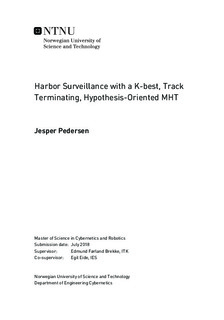Harbor Surveillance with a K-best, Track Terminating, Hypothesis-Oriented MHT
Abstract
A high activity harbor environment could present several problems for a tracking system. The observable area may be small, targets may be closely spaced, move in formation and disappear close to where other appears. Therefore, to perform harbor surveillance one requires a tracking algorithm capable of both robust track initiation, maintenance and termination.
To deal with this, the Hypothesis-Oriented Multiple Hypothesis Tracker (HO-MHT) of Reid is extended to also model the event of targets ceasing to exist. The result is similar to that of Kurien, but is formulated such that the K-Best hypotheses can be generated in polynomial time by the algorithm of Murty. Important design aspects of the algorithm are explained, including track and hypothesis tree data structures, together with additional complexity reduction techniques aside from K-best generation.
The surveillance system is to be used for the autonomous ferry project in Trondheim, Norway, and the objective is to gather statistics for the area the ferry is going to operate in. This is important to both evaluate the impact of the ferry on the existing traffic, and to aid in the development of a collision avoidance system.
A high performing radar detection system is developed, removing 40 % of the clutter, and under 1 % of the true target detections. This includes a filter to remove "multiples" generated by large boats. Measurement and plant noise parameters for a DWNA-model are estimated for the sensor and the targets that operate in the area. Both the optimal parameters of the detection system and the target model is obtained by evaluating it against an approximate ground truth. A Graphical User Interface (GUI) has been made to both facilitate the creation and increase the precision of the ground truth.
Another GUI has been made to analyze the results of the tracking system. It is possible to examine individual clusters and its hypotheses through time. The tracks of a hypotheses is shown on top of a satellite image along with detection data.
